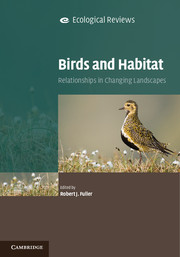Book contents
- Frontmatter
- Contents
- List of Contributors
- Preface
- Part I The complexity of patterns and processes
- Chapter One The bird and its habitat: an overview of concepts
- Chapter Two Habitat quality and habitat occupancy by birds in variable environments
- Chapter Three Spatial variation and temporal shifts in habitat use by birds at the European scale
- Chapter Four Mechanisms and processes underlying landscape structure effects on bird populations
- Chapter Five Avian responses to transitional habitats in temperate cultural landscapes: woodland edges and young-growth
- Chapter Six Habitat associations of birds in complex changing cultural landscapes
- Chapter Seven The importance of habitat heterogeneity at multiple scales for birds in European agricultural landscapes
- Part II Case studies of habitat use and selection
- Part III Wider perspectives
- Species index
- Subject index
- References
Chapter Two - Habitat quality and habitat occupancy by birds in variable environments
Published online by Cambridge University Press: 05 December 2012
- Frontmatter
- Contents
- List of Contributors
- Preface
- Part I The complexity of patterns and processes
- Chapter One The bird and its habitat: an overview of concepts
- Chapter Two Habitat quality and habitat occupancy by birds in variable environments
- Chapter Three Spatial variation and temporal shifts in habitat use by birds at the European scale
- Chapter Four Mechanisms and processes underlying landscape structure effects on bird populations
- Chapter Five Avian responses to transitional habitats in temperate cultural landscapes: woodland edges and young-growth
- Chapter Six Habitat associations of birds in complex changing cultural landscapes
- Chapter Seven The importance of habitat heterogeneity at multiple scales for birds in European agricultural landscapes
- Part II Case studies of habitat use and selection
- Part III Wider perspectives
- Species index
- Subject index
- References
Summary
It is unwise to be dogmatic about the habitat associations of any bird species. Even the classification of species as habitat generalists or specialists requires careful consideration. Perceptions of specialisation depend on how niche breadth is measured and on locational, spatial and temporal context (Devictor et al., 2010; Barnagaud et al., 2011). Close examination of most species reveals variation across individuals in their occupancy and use of habitats. This chapter focuses on the diverse processes affecting habitat choices made by individual birds that determine which patches and habitat types are actually occupied at any particular place and time. Ecologists have given much attention to concepts of habitat quality – these are fundamental to any discussion about the processes of habitat choice. Many of the mechanisms discussed here were initially proposed many years ago (see Hildén, 1965) but, for brevity, I generally cite the recent evidence.
The broad limits of what constitutes potential habitat are set by a combination of the individual’s functional needs and the mechanisms by which it recognises its habitat (Chapter 1). In reality most species, most of the time, do not occupy all potentially suitable habitat. Moreover, for various reasons, individuals may occupy, even select, poor-quality habitats. Habitat occupancy can, very broadly, be thought of as the outcome of an interaction between: (i) habitat quality, (ii) constraints that preclude settlement in part of the potential habitat spectrum, (iii) other factors that may stimulate settlement in certain parts of the potential habitat spectrum and (iv) phenotypic flexibility. This balance of diverse factors determines the observed distribution of birds across habitats. Habitat quality forms a logical starting point.
Information
- Type
- Chapter
- Information
- Birds and HabitatRelationships in Changing Landscapes, pp. 37 - 62Publisher: Cambridge University PressPrint publication year: 2012
References
Accessibility standard: Unknown
Why this information is here
This section outlines the accessibility features of this content - including support for screen readers, full keyboard navigation and high-contrast display options. This may not be relevant for you.Accessibility Information
- 8
- Cited by
